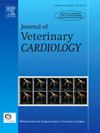猫室间隔壁测量的观察者间可重复性
IF 1.3
2区 农林科学
Q2 VETERINARY SCIENCES
引用次数: 0
摘要
在临床上,超声心动图是诊断猫肥厚性心肌病的金标准试验。超声心动图测量的低观察者间可变性已在文献中普遍报道。我们假设在测量猫室间隔(IVS)厚度时,观察者之间的变异性很高。材料与方法选择4只不同左室形态猫的右胸骨旁左室流出道超声心动图。来自不同机构的29名兽医心脏病专家和心脏病学住院医师对每张图片中的IVS进行了5次测量。采用类内相关系数(ICC)进行数据分析。结果观察者间重复性较差的是IVS的基础(部分ICC: 0.4),中等的是IVS的其余部分(部分ICC: 0.6)。对于IVS的每个图像和区域,在测量的下限和上限之间存在0.7 mm的范围。测量结果中约27%的方差与训练地点(国家)有关,而约73%的方差可归因于观察者。研究局限研究局限包括使用静止图像和仅评估一个超声心动图参数。结论如假设的那样,在猫中使用右侧胸骨旁左室流出道观察IVS测量的观察者之间的可重复性较差至中等。当比较和解释由不同观察者获得的测量结果时,这一发现是相关的。此外,在解释涉及同一设施观察员的变异性研究结果时,可能需要考虑培训地点的影响。本文章由计算机程序翻译,如有差异,请以英文原文为准。
Interobserver repeatability of interventricular septal wall measurements in cats
Introduction
Clinically, echocardiography is the gold standard test for diagnosing hypertrophic cardiomyopathy in cats. Low interobserver variability for echocardiographic measurements has generally been reported in the literature. We hypothesized that interobserver variability is high when measuring the interventricular septum (IVS) thickness in cats.
Materials and Methods
Echocardiographic right-sided parasternal left ventricular (LV) outflow tract views from four cats with different LV morphologies were selected. Five measurements of the IVS in each picture were performed by 29 veterinary cardiologists and cardiology residents from different institutions. Intraclass correlation coefficient (ICC) was applied for data analysis.
Results
Interobserver repeatability was poor for the base of the IVS (partial ICC: 0.4) and moderate for the rest of the IVS (partial ICC: 0.6). A range of 0.7 mm between the lower and upper limits of measurements was found for each picture and region of the IVS. Around 27% of variance in measurements was associated with training location (country), whereas around 73% of the variance was attributable to the observer.
Study Limitations
Study limitations included the use of still pictures and assessment of one echocardiographic parameter only.
Conclusions
As hypothesized, the interobserver repeatability of IVS measurements using the right-sided parasternal LV outflow tract view in cats was poor to moderate. This finding is relevant when comparing and interpreting measurements obtained by different observers. Additionally, the influence of training location may need to be considered when interpreting results of variability studies involving observers from the same facility.
求助全文
通过发布文献求助,成功后即可免费获取论文全文。
去求助
来源期刊

Journal of Veterinary Cardiology
VETERINARY SCIENCES-
CiteScore
2.50
自引率
25.00%
发文量
66
审稿时长
154 days
期刊介绍:
The mission of the Journal of Veterinary Cardiology is to publish peer-reviewed reports of the highest quality that promote greater understanding of cardiovascular disease, and enhance the health and well being of animals and humans. The Journal of Veterinary Cardiology publishes original contributions involving research and clinical practice that include prospective and retrospective studies, clinical trials, epidemiology, observational studies, and advances in applied and basic research.
The Journal invites submission of original manuscripts. Specific content areas of interest include heart failure, arrhythmias, congenital heart disease, cardiovascular medicine, surgery, hypertension, health outcomes research, diagnostic imaging, interventional techniques, genetics, molecular cardiology, and cardiovascular pathology, pharmacology, and toxicology.
 求助内容:
求助内容: 应助结果提醒方式:
应助结果提醒方式:


